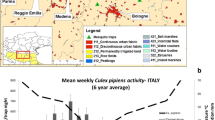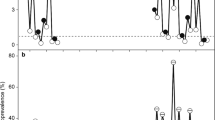Abstract
West Nile virus was first reported in Uganda in 1937. WNV is a zoonosis, with "spill-over" to humans, which also poses significant risks for wildlife, zoo and domestic animal populations. While it is not known how West Nile virus (WNV) entered the New World in 1999, anomalous weather conditions may have helped amplify this Flavivirus that circulates among urban mosquitoes, birds and mammals. We analyzed weather patterns coincident with a series of U.S. urban outbreaks of St. Louis encephalitis (SLE), (a disease with a similar life cycle), and four recent large outbreaks of WNV. Drought emerged as a common feature. As the potential risks from pesticides for disease control must be weighed against the health risks of the disease, an early warning system of conditions conducive to amplification of the enzootic cycle could help initiate timely preventive measures, and potentially limit chemical interventions.
Similar content being viewed by others
References
Rappole JH, Derrickson SR, Hubálek Z. Migratory birds and spread of West Nile virus in the Western Hemisphere. EID 2000; 6: 319–328.
Monath TP, Tsai TF. St Louis encephalitis:lessons from the last decade. Am J Trop Med Hyg 1987; 37: 40s-59s.
Spielman A. Population structure in the Culex pipiens complex of mosquitoes. Bull WHO 1967; 37: 271–276.
Savage H, Ceianu G, Nicolescu G, et al [Karabatsos N, Lanciotti R, Vladimirescu A, Laiv A, Ungureanu A, Romanca C, Tsai TF.] Entomologic and avian investigations of an epidemic of West Nile fever in Romania in 1996, with serologic and molecular characterization of a virus isolate from mosquitoes. Am J Trop Med Hyg 1999; 61: 600–611.
Nash D, Mostashari F, Fine A, et al. [Miller J, O'Leary Durray K, Huang A, Rosenberg A, Greenberg A, Sherman M, Wong S, Layton M; 1999 West Nile Out-break Response Working Group.] The outbreak of West Nile virus infection in the New York City area in 1999. N Engl J Med 2001 344: 1858–9.
Platonov AE, Shipulin GA, Shipulina OY, et al. [Tyutyunnik EN, Frolochkina TI, Lanciotti RS, Yazyshina S, Platonova OV, Obukhov IL, Zhukov AN, Vengerov YY, Pokrovskii VI.] Outbreak of West Nile Virus infection, Volgograd region, Russia, 1999. EID 2001; 7: 128–132.
Marberg K, Goldblum N, Sterk VV, The natural history of West Nile fever. I. Clinical observations during an epidemic in Israel. Am J Hyg 1956; 64: 259–265.
Author information
Authors and Affiliations
Rights and permissions
About this article
Cite this article
Epstein, P.R., Defilippo, C. West Nile Virus and Drought. Global Change & Human Health 2, 105–107 (2001). https://doi.org/10.1023/A:1015089901425
Issue Date:
DOI: https://doi.org/10.1023/A:1015089901425




